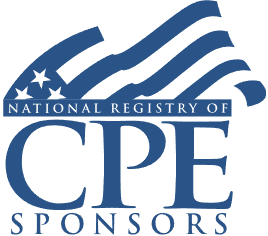Tax Considerations of the CARES Act: QIP Correction, PPP and EIDL Loans, NOL Carrybacks and Contributions

Course Details
- smart_display Format
On-Demand
- signal_cellular_alt Difficulty Level
Intermediate
- work Practice Area
Corporate Tax
- event Date
Tuesday, May 26, 2020
- schedule Time
1:00 p.m. ET./10:00 a.m. PT
- timer Program Length
110 minutes
-
BARBRI is a NASBA CPE sponsor and this 110-minute webinar is accredited for 2.0 CPE credits.
-
BARBRI is an IRS-approved continuing education provider offering certified courses for Enrolled Agents (EA) and Tax Return Preparers (RTRP).
This course will review the latest developments and clarifications of the relief packages so that practitioners can better serve clients suffering from economic losses as a result of the pandemic. The program will benefit tax advisers wading through the massive relief offered to taxpayers to mitigate losses sustained as a result of COVID-19.
Faculty

Mr. Schwarz has over 37 years of experience specializing in legislative affairs, including development and implementation of tax legislation at the national level. He spends his time at the capitol meeting with legislators, listening in on updates impacting tax processes and procedures and providing timely updates and education on issues and opportunities impacting clients. Mr. Schwarz is a sought-after speaker for many AICPA, TEI and FEI conferences.

Mr. Donovan has more than 17 years of tax consulting experience providing R&D tax incentives to a variety of industries, comprising of chemical, food, plastics, medical device and equipment manufacturing, technology, software, engineering, construction, and life sciences.

Ms. Mouw focuses on federal, state and international tax issues. Her key areas of expertise include accounting method issues such as income and expense recognition, capitalization, Section 199 and inventory issues. She has experience with FATCA guidance, co-leads her firm's Repair Regulations initiative, and facilitates numerous internal and external educational sessions related to the repair regulations, Section 199 and accounting method and periods. She leads the firm's accounting methods and period practice helping clients navigate and identify appropriate accounting methods and modifications.
Description
In the first week of April 2020, taxpayers rushed to banks to take advantage of Payroll Protection Program (PPP) loans available to qualified employers with less than 500 employees. With maximum interest rates of one percent, a loan forgiveness feature, and initial repayments deferred for six months, businesses are scrambling to banks to take advantage of these loans.
Also included as part of the relief is an employer retention credit (ERC). A 50% credit for wages paid up to $10,000 is allowed for qualifying employers, including self-employed taxpayers. However, there are specific economic loss requirements to qualify, and employers taking advantage of a PPP loan are not eligible for the ERC. Understanding which is better for which taxpayers is critical for tax advisers.
In addition to loans and tax credits, net operating loss rules that were curtailed by the 2017 tax act have returned. The recent tax act imposed an 80% limitation and removed the carryback. Now businesses have a five-year carryback, no cap, and an indefinite carryforward.
Listen as our panel of tax experts explains what we know and what we don't know about the four phases of coronavirus relief and how advisers can best take advantage of the offerings for themselves and their clients.
Outline
- Business relief
- Economic Injury Disaster Loans
- Paycheck Protection Program Loans
- Employer retention credit
- QIP life
- Business interest limit
- NOL changes
- Individual relief
- Rebates
- RMD waivers
- Retirement plan withdrawal changes
- Unemployment benefits
- Medical payments and HSAs
- Charitable contribution changes
Benefits
The panel will cover these and other critical issues:
- Who is eligible for an Economic Injury Disaster Loan?
- How is loan forgiveness calculated with a PPP loan?
- What are the latest net operating loss carryback rules?
- Which taxpayers need to amend returns to benefit from recent changes?
NASBA Details
Learning Objectives
After completing this course, you will be able to:
- Identify changes to charitable contribution deductions
- Decide which returns may need to be amended as a result of COVID-19 relief
- Determine when losses can be carried back
- Ascertain which taxpayers would benefit from the employer retention credit
- Field of Study: Taxes
- Level of Knowledge: Intermediate
- Advance Preparation: None
- Teaching Method: Seminar/Lecture
- Delivery Method: Group-Internet (via computer)
- Attendance Monitoring Method: Attendance is monitored electronically via a participant's PIN and through a series of attendance verification prompts displayed throughout the program
- Prerequisite: Three years+ business or public firm experience preparing complex tax forms and schedules, supervising other preparers or accountants. Specific knowledge and understanding of pass-through taxation, including taxation of partnerships, S corporations and sole proprietorships, qualified business income, net operating losses and loss limitations; familiarity with net operating loss carry-backs, carry-forwards and carried interests.

Strafford Publications, Inc. is registered with the National Association of State Boards of Accountancy (NASBA) as a sponsor of continuing professional education on the National Registry of CPE Sponsors. State boards of Accountancy have final authority on the acceptance of individual courses for CPE Credits. Complaints regarding registered sponsons may be submitted to NASBA through its website: www.nasbaregistry.org.

Strafford is an IRS-approved continuing education provider offering certified courses for Enrolled Agents (EA) and Tax Return Preparers (RTRP).
Unlimited access to premium CLE courses:
- Annual access
- Available live and on-demand
- Best for attorneys and legal professionals
Unlimited access to premium CPE courses.:
- Annual access
- Available live and on-demand
- Best for CPAs and tax professionals
Unlimited access to premium CLE, CPE, Professional Skills and Practice-Ready courses.:
- Annual access
- Available live and on-demand
- Best for legal, accounting, and tax professionals
Unlimited access to Professional Skills and Practice-Ready courses:
- Annual access
- Available on-demand
- Best for new attorneys
Related Courses

Mitigating Personal Holding Company (PHC) Tax for Franchisors and Closely Held Businesses
Thursday, June 26, 2025
1:00 p.m. ET./10:00 a.m. PT